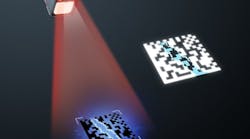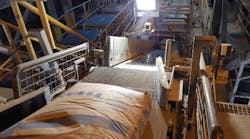Satellite radar and remote sensing map Land-surface changes
By Shari L. S. Worthington, Contributing Editor
Subsidence, the lowering or collapsing of the land`s surface, has plagued the oil and gas industry for ages. In some cases, natural subsidence occurs when the ground collapses into underground cavities produced by the solution of limestone or other soluble materials by groundwater. Most of today`s occurrences, though, are human-induced, a result of underground mining or drilling. Such activities weaken the support structure for rocks surrounding oil wells and eventually cause them to collapse from their own weight. These activities affect the ability to extract oil or gas
and also damage the ground infrastructure, affectingthe water management of large land areas (see Fig. 1).
To solve this problem, oil-exploration companies are teaming up with software developers and government space agencies to take advantage of the huge imaging databases accumulated from satellite surveillance efforts. For example, a collaboration of Shell E&P Technology Co. (Houston, TX) and Atlantis Scientific (Nepean, Ont., Canada), partially funded by the EOP3 program of the Canadian Space Agency (Saint-Hubert, Quebec, Canada), has accomplished timely and cost-effective remote monitoring of suspect land areas. Using new imaging techniques involving differential interferometric synthetic aperture radar (SAR), Shell can create deformation maps that provide accurate pictures of virtually any surface in the world. Armed with detailed information of surface motion at the millimeter/centimeter/inch level, the oil company`s goal is to counter surface subsidence and prevent oil-well failures in the future.
Scoping the globe
Achieving highly precise surface images begins with a remote-sensing satellite equipped with SAR that uses energy transmitted at microwave frequencies (see Vision Systems Design, May 1997, p. 22). The remote-sensing radar satellite transmits a microwave energy pulse to Earth and then measures the amount of energy that returns to the satellite (backscatter) after it interacts with the Earth`s surface. In the satellite, the power of the backscatter electromagnetic radiation is recorded, as well as its phase (see Fig. 2).
In radar interferometry, a change in phase is measured between the returned signals of two different SAR images of the same target terrain, taken from slightly different positions or at different times. This method is used to generate a digital elevation model (DEM). The generation of this model is part of the process of creating the required deformation map (see "Creating a deformation map" on p. 44).
In repeat-pass SAR interferometry, two SAR images of the same area from almost identical perspectives are coregistered and combined into what is called an interferogram. The phase difference for each pixel in the interferogram is a measure of the change in distance between the scatterer and the SAR antenna between images.
From the phase information, a digital elevation model can be derived (as long as no large-scale deformation occurs between the recordings) with meter/feet accuracy. This sensitive measurement technique allows the measurement of deformation effects on the Earth`s surface over large areas with subcentimeter accuracy. Measurements can even be taken in areas dominated by cloud cover, which are inaccessible by optical sensors. Because the radar is an imaging device, the information on deformation or height can be obtained for virtually every pixel within the scene.
Preventing oil-well failures
Recently, Shell put the differential interferometric SAR to use at several of its California oil fields. At its Belridge field, oil production has been successful for more than a decade by extraction from a layer of diatomite sandstone. However, this rock is continuously compacting due to the reduction in pressure caused by the removal of oil. The compression and local collapse of the sandstone cause frequent oil-well failures. In the southern part of the Belridge oil field, steam injection has been used in an attempt to reduce the subsidence. This approach has decreased the subsidence, but well failures are still occurring. In some areas, more than ten feet of subsidence has resulted, and well failure rates are averaging more than 3% per year, costing the company several million dollars per year.
Under the supervision of Shell nonseismic-methods-specialist Edward Biegert, a program of monitoring and research has been used to help the company understand the dynamics and extent of the subsidence. Conventional terrestrial measurements, called monument measurements, have been used in the past to map the subsidence. These point measurements don`t provide a proper 2-D overview, however,and the data are expensive to collect (see Fig. 3).
Shell needed a remote-sensing technique that would provide high-accuracy maps of subsidence. To that end, Biegert considered several existing techniques for deriving topographic maps from space imagery, including photogrammetry, global positioning systems (GPSs), optical remote sensing, and interferometry. Ultimately, the differential-interferometric SAR (INSAR) technique was chosen. Says Biegert, "A major restriction of photogrammetry and optical remote sensing is cloud cover. Because SAR is an active sensor, it creates its own illumination at a wavelength that penetrates clouds. And although a GPS is an ideal system for point positioning, one would need some 37.5 million GPS receivers to reach the same coverage as a SAR quarter scene. Finally, optical satellites are simply unable to detect deformation."
Although INSAR can only reach the leveling accuracies of terrestrial height-measurement techniques in ideal circumstances, it shows promise for obtaining accurate height-change information at every pixel from just two observations. This nearly continuous coverage of an area located anywhere on Earth makes it an attractive measurement method. Because the height information obtain by INSAR is a relative measurement, it can play a complementary role when combined with absolute GPS measurements.
For Biegert`s research, Canada`s RADARSAT satellite was used to acquire SAR imagery over the Shell oil fields at Belridge, Lost Hills, and Rocky Mountain Arsenal. The goal was to monitor ground subsidence, observe the progress of large-scale grading operations, and generate accurate digital elevation models. In addition, past data from Europe`s ERS-1 and ERS-2 satellites were analyzed. However, RADARSAT provided more precise data with its spatial resolution approaching 6.25 m versus the data obtained by ERS-1, where each pixel was 25 m on a side.
Interferometry in progress
After the data source was chosen, a suitable computer system and related software were needed to gather the incoming data and generate imaging models. Biegert`s software choice was EarthView InSAR from Atlantis Scientific (Nepean, Ont., Canada). EarthView InSAR is a software application designed to produce elevation models and height-change maps through the use of repeat-pass interferometry. The software includes semiautomated processing and tools for handling poor-quality data, as well as image-processing functions for general remote-sensing data enhancement. The software was installed on a 300-MHz Sun Microsystems UltraSparc-2 workstation, with 256 Mbytes of RAM and a 60-Gbyte hard drive.
Data sets were ordered from RADARSAT and ESA-ESRIN, which were delivered to Atlantis Scientific on Exabyte tape. The EarthView InSAR software was used to process all the scenes. Highly accurate orbit data from Delft University of Technology (The Netherlands) were incorporated during processing to coregister the two SAR images. Subsequent processing included flat-earth phase removal, spectral filtering, removal of elevation phase contributions using external DEM, interferogram enhancement, coherence map generation, phase unwrapping, height-change map generation, terrain distortion removal, and geocoding--all the procedures required to generate a deformation map.
Because the analyzed data covered a wider area than South Belridge, Shell was able to detect several other instances of subsidence. The Lost Hills oil field north of Belridge revealed more dramatic subsidence than that found at Belridge. Two more subsiding areas were also found within the city limits of Los Angeles (see Fig. 4).
Applications of digital elevation models have proven valuable for companies in the oil and gas exploration industry. These maps save companies large sums of money when planning future exploration efforts. In addition, replacing low-resolution DEMs with SAR interferometric DEMs yields higher accuracy.
FIGURE 1. Land-surface movement, also known as subsidence, is imaged with the assistance of EarthView InSAR software from Atlantis Scientific. This software produces land elevation models and height-change maps through the use of repeat pass interferometry and image-processing functions for general remote-sensing data enhancement.
FIGURE 2. To measure surface deformity, a radar remote-sensing radar satellite transmits a microwave energy pulse to Earth, then measures the amount of energy that returns to the satellite (backscatter) after it interacts with the Earth`s surface. In the satellite, the power of the backscatter electromagnetic radiation is recorded, as well as its phase. In radar interferometry, the change in phase is measured between the returned signals of two different SAR images of the same target terrain, taken from slightly different positions or at different times.
FIGURE 3. Conventional terrestrial measurements, called monument measurements, have been used in the past to map land-surface subsidence. Its point measurements, however, don`t provide a proper 2-D overview, and the data are expensive to collect. Imaging techniques involving differential interferometric synthetic aperture radar (SAR) can create deformation maps that provide accurate pictures of virtually any surface in the world, at much less cost.
FIGURE 4. Because the analyzed data covered a wider area than South Belridge, several other instances of subsidence were detected. The Lost Hills oil field north of Belridge revealed more dramatic subsidence than that found at Belridge. In addition, two more subsiding areas were also found within the city limits of Los Angeles.
Creating a deformation map
Interferometric synthetic-aperture-radar (SAR) technology requires a radar satellite to make two separate passes over the area of interest from two different positions or angles. Then, the SAR phase information in the two repeat-pass SAR images must be correlated. Correlation, or coherence, is defined by: the SAR satellite follows the same track through space within a few hundred meters, and the fine scale-scattering characteristics must be identical in the two images. If the data have coherence, then an interferogram can be generated. This interferogram will contain information that shows topography and surface-change information.
Using a digital elevation model (DEM), the topography of the area of interest can be removed, leaving only land-surface change information. The result--a differential interferogram--is processed and converted to a geocoded deformation map. Geocoding refers to the process of applying map projections, such as latitude and longitude, to the deformation map. Now, a person is able to relate the deformation map to geographic position. The DEM accuracy is usually described in meters. The deformation map can measure motion on the order of millimeter/centimeter accuracy.
S.L.S.W
Special thanks to Tim Benner, business development manager at Atlantis Scientific, for his assistance with this article.









